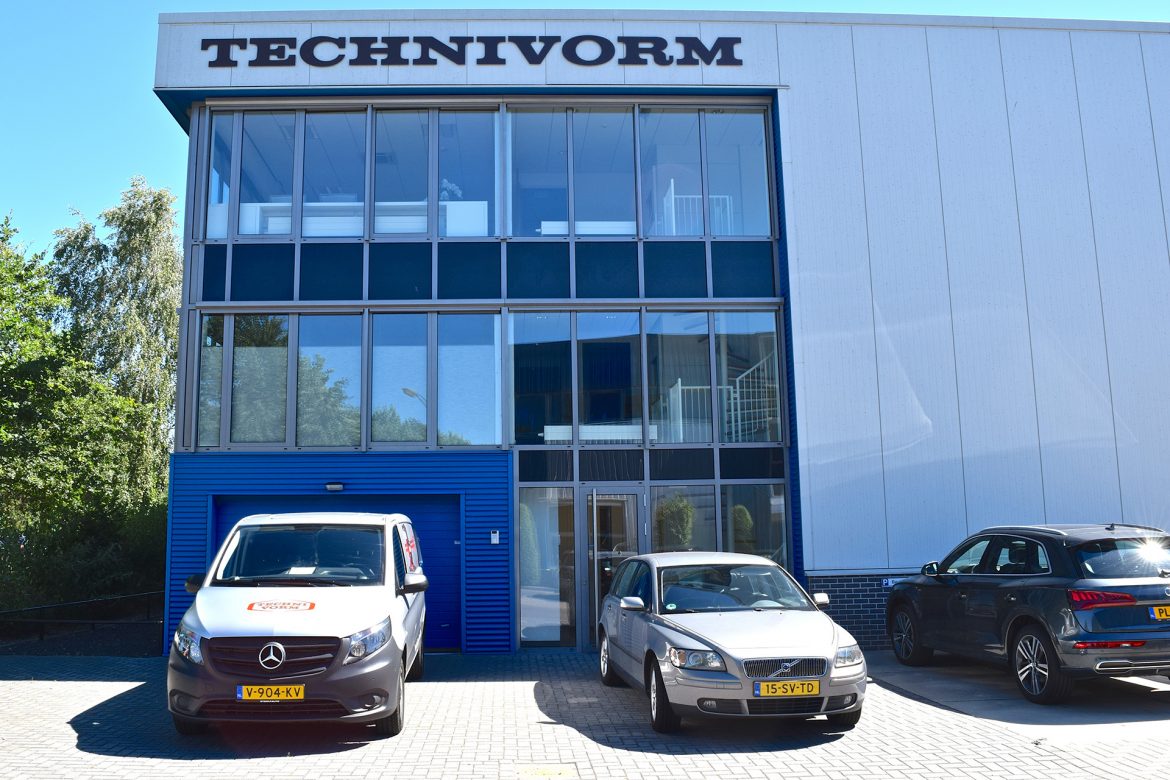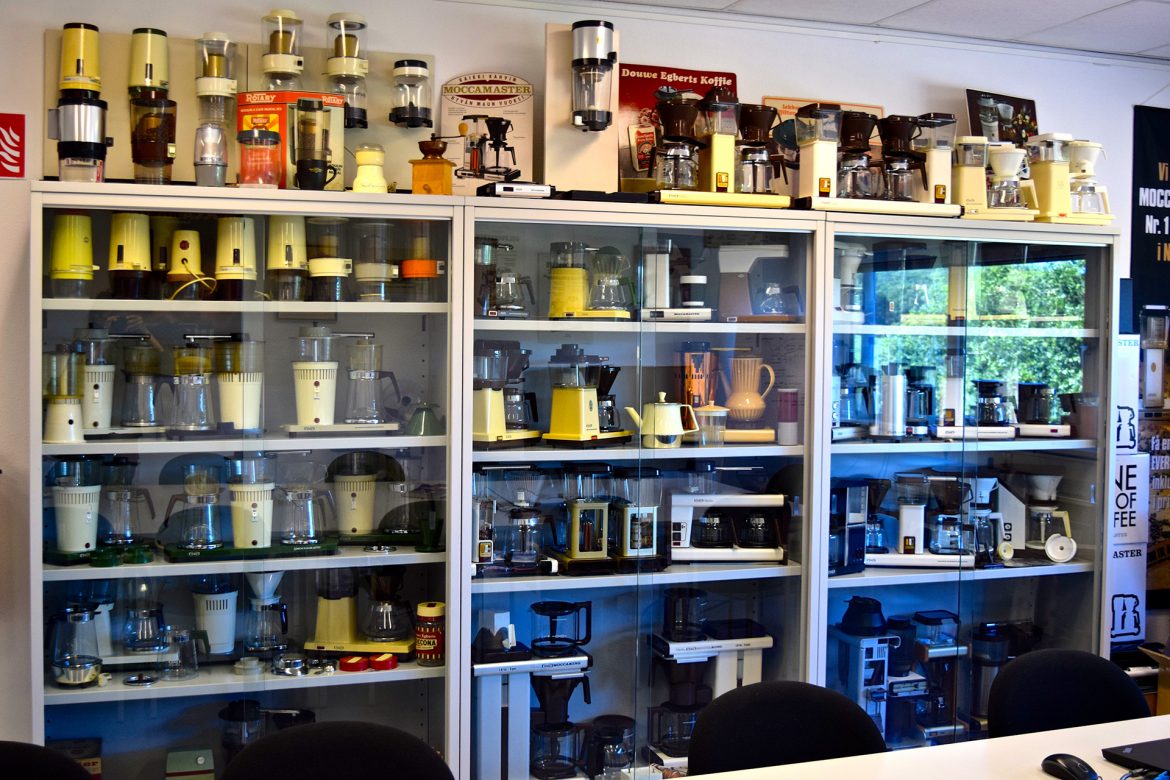
Only five people in the world, I’m told, possess the lapel pin: a golden hexagon with block serif letters split over two lines. One is the person whose dark glen-plaid blazer buttonhole I’m inspecting right now under institutional lighting in Amerongen, the Netherlands. His name is Frans van Cooten. His title nowadays is director and owner of Moccamaster Sales EU, one of three independent entities overseeing the majority of sales for the manufacturer known as Technivorm—which is also the word, shining in relief, on Van Cooten’s lapel.
2018 was a momentous year for the factory that created the world’s most enduring, stylish, and reputable home filter coffeemaker: the Moccamaster KBG 741. The year began sadly, with the passing of the machine’s inventor and Technivorm’s founder, Gerard-Clement Smit. In January, the engineer died at age 87. Years ago, he had given Van Cooten, his son-in-law, the Technivorm pin—although the first to receive one was Ina ten Donkelaar. She is not wearing it on the bright morning on which she tells me who is in the circle of pin-possessors, but no one doubts how close the brand is to her heart. She was Smit’s partner. Currently, Ten Donkelaar is Technivorm’s CEO and has been with the company, established in 1964, from early on. She remembers when Smit rented a workspace in the tiny village of Elst, in the province of Utrecht, initially producing stepladders and stacking shelves, followed by his first patented coffee grinder in 1965. She recalls when, in 1967, Technivorm moved to the neighboring village of Amerongen, right into Smit’s backyard, which was convenient, yet rough on his prune trees.


The rerelease of Technivorm’s first-ever coffeemaker made 2018 more celebratory. Developed in 1968 but launched a year later, the Moccamaster 69, named for its debut year, is smaller than the 741 (brewing up to eight, rather than 10, cups). With a round-edged hotplate tray and a circular heating tower and water reservoir, it very much appears to be of a curves-embracing era. Called the ’68 Jubileum, the rerelease retains those features, making it an unblinking fit into all the mid-century modern design resurrected of late. The limited-edition model has been available in Europe since March 2018. North America has had to be patient, as it is only scheduled for purchase there starting spring 2019.
Ten Donkelaar and Van Cooten receive me at Technivorm’s headquarters and factory in Amerongen. No longer occupying the family’s former garden, they have been situated in an industrial section of town since the late 1980s. Still, in the Netherlands, it’s hard to ever really get away from the pastoral; trees surrounding the premises are lush and across the road, I catch a couple of ponies grazing. In traditional Dutch office etiquette, a receptionist promptly offers drinks. White demitasses arrive, filled with a medium-dark roast provided by two-centuries-old Dutch roasters Smit & Dorlas. When I ask, perhaps a bit insipidly, if a Moccamaster was used, Van Cooten answers with an amiable “Jaaaa.” Downstairs, he volunteers, professional-line Moccamasters brew fresh batches for the factory staff. An 11 AM coffee break is another Dutch labor institution, but the punctuality of a koffiepauze is crucial when a production line is at stake, stresses Van Cooten. A bell goes off to let the workers know when it’s time for, as Ten Donkelaar puts it, “drinking coffee, getting a little baked good, and enjoying a smoke.”

But upstairs, we are in what seems to be part boardroom—upholstered conference chairs tucked under laminate tables—and part museum. Exhibited in, on, and around glass-cased shelves are decades’ worth of artifacts: various models and iterations of home and commercial coffee machines, blade coffee grinders, hot plates, water boilers, and dispensers. Plus, there are samples of Smit’s pre-Technivorm inventions from when he was, essentially, a freelancer; highlights include a box of hot rollers and a snijbonenmolen (a string bean slicer, once considered a Dutch kitchen staple). The walls are like an open scrapbook, decorated with vintage corporate posters and multi-language ads from the past. On a stand of its own is a quilt: the batik-effect fabric with images of cups and beans features a dozen blocks, each with a uniquely hued 741 machine. It was occasioned by Technivorm’s golden anniversary, and the quilter was Kathleen Bauer, COO of Moccamaster USA, a second of Technivorm’s three related entities. Bauer is another pin-holder, and her craft brings some palpable Americana to the functionalism-driven European environs.
Moccamaster’s internal functions were uncovered by Popular Mechanics in a “disassembly report” detailing all 137 parts that are elegantly engineered into a single 741. The 2017 review praised it as “many coffee snobs’ brewer of choice,” though the machine’s appeal has undeniably broadened. The MoMa Design Store has sold it since 2016, and in June 2018, “new brides and brides-to-be” among Good Morning America’s staff ranked it their #1 wedding gift.


These days, the brand has distributors worldwide. Nevertheless, all Moccamasters continue to be constructed by hand and individually tested in the Netherlands. The manufacturer prides itself in using, whenever possible, recyclable or fully degradable materials sourced from within Europe, if not the Netherlands itself. New machines come with a five-year warranty, though tend to last far longer, being easy to repair or spruce up with replacement parts.
“We get lots of emails from customers asking, ‘Does the jug for the new 68 also fit in the old one?’ And they’re very happy to hear that it does,” says Van Cooten. The rerelease has a few technical updates, but “on functionality there is no difference.”
“This was the first ’68 model, back then called the ‘69,’” Ten Donkelaar specifies of an antique machine being stored behind glass. “We sold 769,473 pieces.”

In 2010, after selling off a local horse feed business inherited from his father, Van Cooten founded Moccamaster Sales EU. The move was steered by having agreed with Smit to find new markets for Moccamaster upon joining the enterprise of his spouse’s family. Clementine Smit, Van Cooten’s wife, once worked at Technivorm herself, though now is more likely to be found accompanying Van Cooten to coffee shows and festivals, he says, adding, “she know the product very well—she knows everything.”
Van Cooten and his team concentrated on Germany, Central Europe, and the UK. Scandinavia was not part of their remit because Technivorm had, since the early 1970s, been exporting to the region. It has remained the company’s biggest market for the last 30 years. Moccamaster Nordic, a third entity in the trio, handles these operations. Those strong ties are veritably sealed in a seal. Found on all Moccamasters is a sticker reading “approved” along with the name of the European Coffee Brewing Centre. Founded in 1975 in Oslo, the ECBC is an offshoot of the Norwegian Coffee Association, and testing brewers is its raison d’être.
Van Cooten explains: “In the Scandinavian countries, everyone knows about the ECBC, and our whole range passed this certification of brewing the perfect cup. For the ECBC, it’s not about the quality of the machine or the expected lifespan of the machine—they only certify based on achievement of the best brew, to reach the best extraction out of your coffee.”
To illustrate just how omnipresent, if not ho-hum, the Moccamaster is in the Nordics, Van Cooten asks if I’ve been tuning in to Dutch TV’s Detective Month, which airs crime series.
“If you watch the Scandinavian shows carefully,” he says, “probably at least once a week, you have a shot in the kitchen, no matter where the crime scene is, and they pour coffee with a Moccamaster.”

The younger of Van Cooten and Clementine Smit’s two children seems on track to wear a pin one day too. Rob van Cooten recently completed his third year of business school and has already done sales and marketing work in his father’s office. The elder Van Cooten says his son is interested in pursuing the family trade after graduating and getting some experience abroad. Daughter Floortje van Cooten keeps busy as an Amsterdam-based fashion blogger, though in a recent Father’s Day gift guide took the opportunity to call a Moccamaster the “best present there possibly is.” Her post spotlights a shiny stone gray KBG 741.
As Ten Donkelaar likes to say, the 741 is “an evergreen.” Developed in 1974, it hit the market two years later and today is the most iconic model. The Moccamaster remains one of several select home brewers certified by the SCA, reflecting its esteemed status among, to quote a Sprudge article on the brand’s Cup-one, “prosumer appliances.” It is true that Technivorm and specialty coffee have been friendly for decades. In 1988, the Dutch company became a founding member of the Specialty Coffee Association of Europe, and fast-forward to World of Coffee 2018, the Moccamaster stand was showing off the 741 in its latest colors: pastel green, pastel yellow, pastel blue, and midnight blue.


Globally, Technivorm and Moccamaster have about 200 employees. Amerongen hosts around 150. In August 2017, the European Coffee Trip published a cheerful video taking viewers inside the factory, profiling workers, and zooming in on the production line.
“We hope to build our 10 millionth this year,” Van Cooten said in that interview.
When, 11 months later, I follow up on the stated projection, he replies: “Yes, we did.”
Turns out, the 10 millionth coffeemaker was handed to Gerard-Clement Smit during a company celebration that coincided with the last birthday he lived to experience, in September 2017. The machine is a black and white Jubileum ’68. It is displayed in a hallway on an encased stand, with mini-spotlights flanking the keepsake. Above is a classic portrait of Smit, raising a cup to his smile. Below is the milestone, its numbers printed larger than all the other text, the Technivorm logo included.
“We just wanted to do the rerelease as an honor to Gerard,” Ten Donkelaar shares.
“But the second 10 million will not take that long,” she continues, returning to the brisker pace of business talk. “We are doing some internal movements to get more space for the production line. Last year, for the first time, we realized more than 500,000 machines—that was a lot of coffeemakers. And this year we will even sell more.”
Karina Hof is a Sprudge staff writer based in Amsterdam. Read more Karina Hof on Sprudge.

































